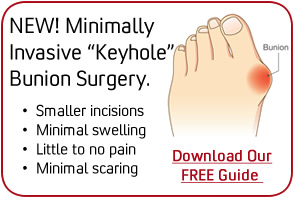|
Cocked Up Big Toe - Hallux Hammertoe
The big toe, called the Hallux, is made up of two small bones called phalanges. This condition presents as a cocking up of the big toe at the joint between these two small bones. In the early stages of the condition the deformity is flexible, in later stages the deformity becomes rigid. It is caused by a variety conditions. Neurological diseases that cause muscle weakness or muscle imbalance in the muscles of the lower leg can result in the formation of Hallux hammertoe. This is commonly seen in patients after they have suffered a stroke or Cerebral Vascular Accident. Damage to certain areas of the brain during a stroke will frequently result in weakness and/or paralysis on one side of the body. If the stroke is not severe the patient may recover a majority of the function of the muscles in the legs and feet. However a residual result may be a cocking up of the big toe. Other causes of the condition include damage or laceration to the tendon on the bottom of the big toe. Surgery to correct bunion deformities, in rare cases, may result in an imbalance of the structures about the big toe joint and cause the condition. An additional cause of hallux hammertoe is the absence of two small bones, called sesamoid bones, which are normally present beneath the big toe joint. There is an uncommon condition where a person may be born without these bones. More commonly however, the absence of one or both of the sesamoid bones is due to their surgical removal. In the course of correcting a bunion deformity one of the sesamoid bones may be removed. In another situation, a fracture of one or both of the sesamoid bones may result in the necessity to remove them to cure the pain associated with the injury (See the description of sesamoditis). A high arched foot may also result in the formation of, not only a hallux hammertoe, but also hammertoes of all of the toes. A consequence of having a hallux hammertoe is irritation on the top of the toe from shoe pressure or the development of a painful callus on the end of the big toe. People who have had a stroke or who have diabetes with peripheral neuropathy may not have pain associated with the callus on the end of the toe. These areas may ulcerate and become infected. Diagnosis The diagnosis of hallux hammertoe is made by clinical exam. An x-ray is useful in determining the degree of the deformity and the condition of the joint. The presence or absence of the sesamoid bones is also made using an x-ray. If a neurological condition has not been identified and there is absence of trauma or previous surgery in the area, then evaluation by a neurologist may be appropriate. Treatment The need for treatment is based upon the level of symptoms the patient may be experiencing. Splitting the toe in an attempt to straighten it is of little value and is certain to fail. If treatment is needed, surgical correction of the deformity has the greatest level of success. If the deformity is flexible a simple tendon release procedure can be performed. This consists of making a small incision on the side of the toe and cutting the tendon in the bottom of the toe. If an ulceration or open sore is present on the end of the toe cutting the tendon to relax the toe may be all that is necessary to allow the ulceration to heal. This procedure can easily be performed in the doctor's office under a local anesthesia. Following the surgery a dressing is applied to splint the toe in a straighten position. The sutures and the bandage are kept in place for 7 to 10 days. The patient should keep their activities to a minimum during this period of time and keep the area dry. A post-operative type of shoe is worn to accommodate the bandage. Generally a patient can return to normal shoes within two weeks and resume complete normal activities in three weeks. If the deformity is rigid then fusion of the joint will be necessary to correct the deformity. Under certain circumstances the foot surgeon may elect to fuse the toe when the deformity is flexible. Fusion of the toe requires removing bone at the level of the joint in the toe. The articular surfaces of the joint are removed and the two small bones are abutted up against one another and held in place by a small screw. This fuses the two pieces of bone together resulting in permeate straightening of the toe. This procedure is generally performed in an out-patient surgery center or hospital. The surgery can be performed under a local anesthesia but the patient and surgeon may prefer to use a twilight anesthesia for the patient's comfort. Following the surgery a fluff dressing is applied. The sutures will remain in place for 7 to 10 days. During this period of time the patient should significantly reduce their activities and keep their foot elevated. It takes 6 weeks or longer for the bones to fuse. During this period of time the patient should wear a stiffed-soled post-operative type of shoe. Bending of the toe will delay or inhibit the fusion of the bones. Quite often it takes three months before the patient can return to full-unrestricted activity. Possible Complications Possible complications include infection, excessive swelling, and delays in healing or failure of the bones to fuse. Overall the procedure has a very high success rate. On occasion, over time, the screw may begin the cause irritation on the tip of the toe and have to be removed. Article provided by PodiatryNetwork.com.
|










